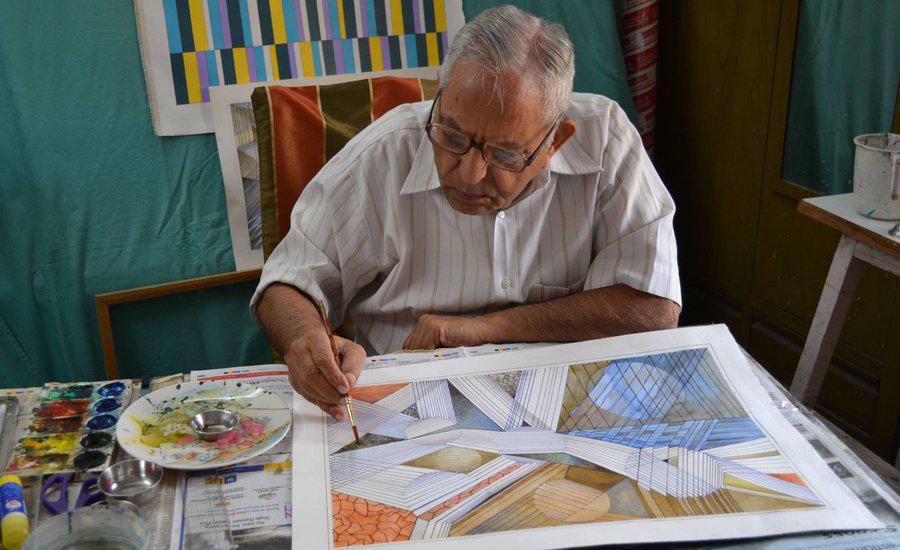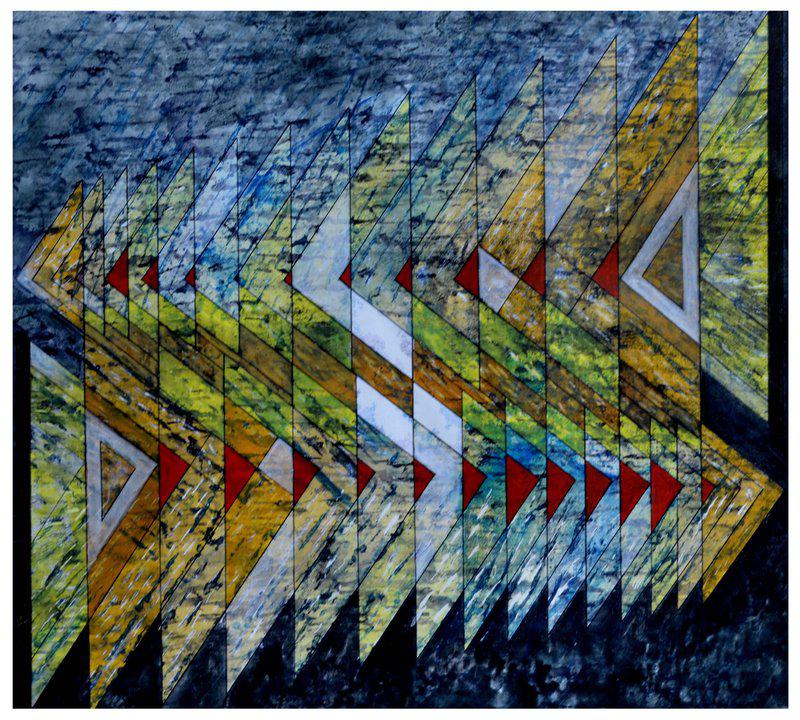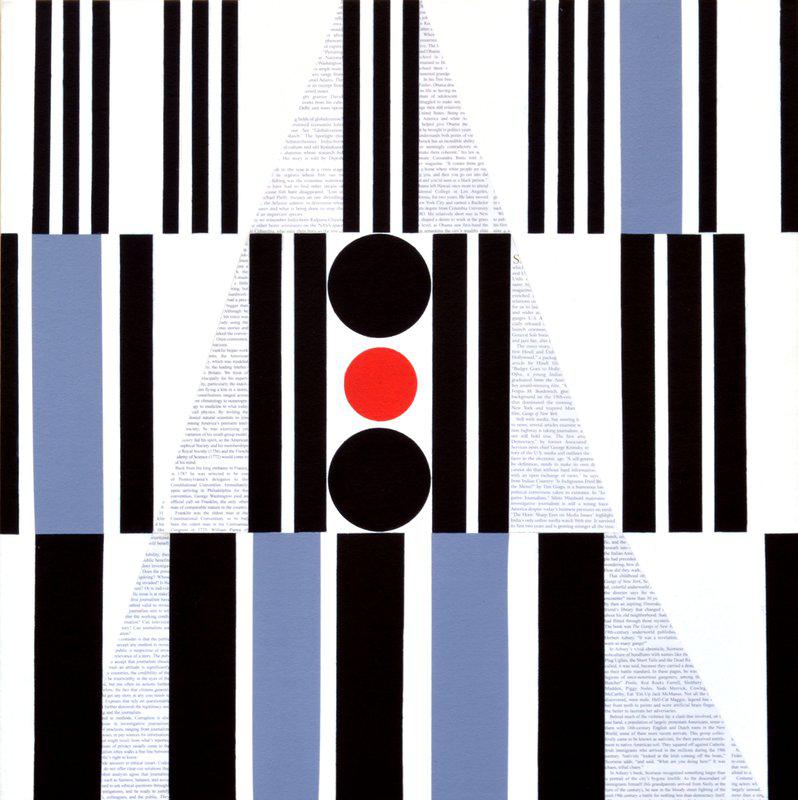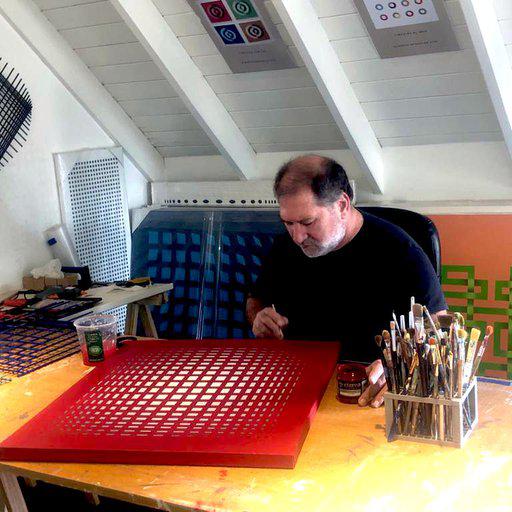Paul Klee’s characterisation of drawing as a ‘line on a walk’ isn’t quite active enough for the Indian artist S.K.Sahni. His lines have gone on something of a life-long odyssey, since he first began wielding a paint brush, back in the early 1950s.
The artist, who was born in 1937, has taken on all manner of stylistic and practical changes; he served on the curatorial staff at the National Gallery of Modern Art in New Delhi; he has had his work displayed in solo exhibitions across the Indian subcontinent and elsewhere in the world; and has seen his work added to prestigious private and public collections, including the National Gallery of Modern Art, New Delhi, the Govt. Museum & Art Gallery, Chandigarh, and the Alkazi Arts Foundation & Osian Foundation, New Delhi.
Throughout this illustrious career, those lines endure, and continue to engage art lovers across the globe, and find new routes to collectors. Sahni is one of many contemporary artists who has chosen to offer his work directly via our site, rather than through a traditional gallery setting. In this interview he describes his earliest artistic works, his latest creations and his enduring sources of inspiration.
S.K. SAHNI – Abstract Space - V, 2017
How would you describe what you do? I do my work with total freedom and my work develops on its own.
Most of your titles feature the word space – why is that? For me the title of the work is for its identification only. In 1982 when I started, I titled my works as Drawing No.I…II and then in 1997 it changed into Introvision–I…II. However, in 2000 after a lot of thinking I found Space the word most appropriate for the kind of work I was doing.
Do you see your work as a series of shapes or is something else lurking within them? Since I worked with straight lines, certain geometrical shapes are bound to emerge while in the process of creation. Those shapes do not have their meaning as such or represent any specific thought or idea. My works are abstracts and totally non-figurative.
Could you describe your process? It would be futile to explain my process as there is none. My foremost effort is that each work is to be different than all the works done earlier. So the process changes with each work. However, a few tendencies do continue which can be noticed in my works such as that all lines have to be just straight of equal strength and painted areas are mostly flat.
What made you want to become an artist? At a very early age, I showed interest in art, though the conditions were not conducive. My drawing teachers appreciated my work and encouraged me. After my 10th level in 1958, I decided to join Sir JJ School of Arts, Mumbai, India.
What was your earliest art creation? In front of our house during 1952-54, there was a sign board-painter shop, where I used to spend all my free time after school hours. The painter worked for the whole day writing sign boards and painting some images in enamel paint. I watched him and also helped him with some minor works. He taught me many basic elements. I painted a few images in enamel and I also made a few copies of pictures on paper published in a fortnightly Hindi magazine. Those were my earliest artworks which have flown away with time.
S. K. SAHNI – Abstract Space H , 2015
How has your work changed over the course of your career? It has changed a number of times but always within my format. 1990 was the first major shift, in medium, from paper to canvas. In 1997 I used masking tape for the first time which affected my creations to some extent in the following years. During 2000 I painted a small image, and cut it into strips of small width. A small collage was created. Based on this experience later on I painted many works. This proved to be a major shift or development in my work. In 2017 I had my show at the Museum of Geometric & MADI Art, Dallas and on my return to India, a new series ‘Painting Strips’ with a fresh approach, I started and continue to work till today.
What should people look for in your work and what do you hope they might get out of your art? An artist creates work first for himself but sharing it with others to awaken their inner self is equally important. People should approach my work without any preconceived notions or ideas. They should allow their mind to accept the unexpected, unusual and out-of-box aspects of my art. They need not understand them as such, but should feel, realize and experience them. The love for works of art should be their in-built part. It is true that a visitor may get nothing as describable in words but his viewing will be important as a sharing of my experience with them to awaken their aesthetics and creative sensibilities.
Tell us a little about three of your works on Artspace I do not like to write or say anything about my works as I believe that visual art has its own language and is to be understood visually. When an artist even gives a title, the spectator instead of seeing the work spends all his time searching for the title. However, I may mention a few points about the three works, as you ask.
S. K. SAHNI – Abstract Space - Q, 2016
Abstract Space-Q . In this work, there are lots of movements between the lines. The lower portion moves us to look upward but before you reach there, the middle portion's lines push you down. Color and texture accentuates these movements further. The little reds add strength to the work.

Space-G. To me this work takes me into Space. It is as if your are looking down from the plane at night. There is a vanishing point to which all lines follow strictly. A small space at the extreme bottom creates the desired depth in the work.
S. K. SAHNI – Space within Space -2 2017
Space within Space -2 . The heights and width of black lines have mathematical proportions to build necessary connections between them. The red circle placed almost in the center is there to control the movements in the picture area. I personally like and enjoyed this work very much as it is directing me to explore more possibilities in this direction.
What do you think you’d be doing if you weren’t doing this? Before going to Sir JJ School of Arts, I had done a Diploma in Draftsman Civil and became interested in architecture. So certainly I would have been an architect.
Where do you look for inspiration? Just within.
How do you get your creativity flowing? It comes on its own. Once I start my work, it invites me to continue to reveal its hidden mystery.
If you could choose any artist on earth to do your portrait who would you choose? I'm not interested particularly interested in a self-portrait. However, if pressed, I would like David Hockney who is a very versatile, talented and understanding painter of contemporary art, to do it.
To see more of S. K. Sahni 's work visit his page on Artspace, here .




























